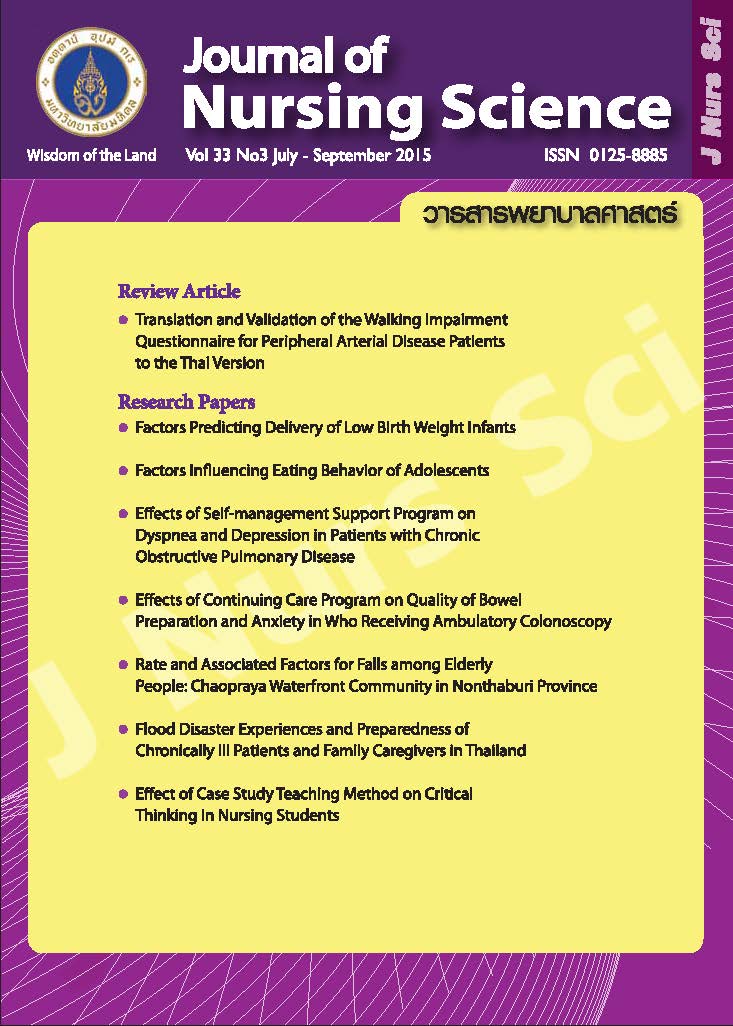Effect of Case Study Teaching Method on Critical Thinking in Nursing Students
Main Article Content
Abstract
Purpose: The study aims to investigate the effect of a teaching method using case study on critical thinking of nursing students and to study the opinion of nursing students in teaching method using case study on critical thinking.
Design: Mixed methods research design.
Methods: Population of the study consists of 67 third year nursing students who attended the course of nursing care of child and adolescent. Before attending the class, all students were requested to do the critical thinking assessment questionnaire. During attending the class for approximately six times, the teaching method based on both the lecture and case studies was utilized. At the end of the course, they were requested to do the post-test and the focus group discussion consisting of 12 nursing students concerning the opinion of critical thinking and the method of teaching. The descriptive statistic, t-test and content analysis were employed in the quantitative and qualitative analysis.
Main findings: Findings from this study revealed that at the end of the course, students got the critical thinking score at a moderate level and, in particular, there is no significant difference between the critical thinking ability before and after learning via the case-study teaching method (p = 1.86ns). It was found from the content analysis that nursing students generally defines the critical thinking as “thinking and reflecting in a systematic manner”. The Teaching method using case studies allows nursing students to practice their thought process in a step-by-step and repeating fashion and this skill can further be exercised during the ward training.
Conclusion and recommendations: Nursing curriculum should integrate the teaching methods that can both stimulate and enhance the critical thinking ability of students in all nursing subjects for the continuous skill development.
ผลของการเรียนการสอนโดยใช้กรณีศึกษา ต่อความสามารถในการคิดอย่างมีวิจารณญาณของนักศึกษาพยาบาล
บทคัดย่อ
วัตถุประสงค์: เพื่อศึกษาผลของการสอนโดยใช้กรณีศึกษาต่อความสามารถในการคิดอย่างมีวิจารณญาณและศึกษาความความคิดเห็นของนักศึกษาพยาบาลเกี่ยวกับการจัดการเรียนการสอนโดยใช้ กรณีศึกษาต่อความสามารถในการคิดอย่างมีวิจารณญาณ
รูปแบบการศึกษา: การวิจัยแบบผสมวิธี
วิธีดำเนินการวิจัย: ประชากรเป็นนักศึกษาหลักสูตรพยาบาลศาสตรบัณฑิต ชั้นปีที่ 3 จำนวน 67 ราย ที่ศึกษาวิชาการพยาบาลเด็กและวัยรุ่น โดยให้นักศึกษาทำแบบทดสอบความสามารถในการคิดอย่างมีวิจารณญาณ ก่อนการเรียน หลังจากนั้นให้นักศึกษาเรียนบรรยายร่วมกับการใช้กรณีศึกษาท้ายชั่วโมง จำนวน 6 หน่วย และตอบคำถามกระตุ้นความสามารถในการคิดอย่างมีวิจารณญาณแบบมีขั้นตอน จำนวน 7 หัวข้อ ใช้เวลารวม 6 สัปดาห์ เมื่อสิ้นสุดการเรียนการสอนในวิชา ให้นักศึกษาทำแบบทดสอบ หลังเรียน และสนทนากลุ่มนักศึกษา จำนวน 12 คน เกี่ยวกับความคิดเห็นในการจัดการเรียนการสอนรูปแบบดังกล่าว หลังจากนั้นวิเคราะห์ข้อมูลเชิงปริมาณคือ ความสามารถในการคิดอย่างมีวิจารณญาณก่อน และหลังเรียนด้วยสถิติทีคู่ และข้อมูลเชิงคุณภาพจากการสนทนากลุ่มด้วยการวิเคราะห์เนื้อหา
ผลการวิจัย: ภายหลังเรียนนักศึกษามีคะแนนความสามารถในการคิดอย่างมีวิจารณญาณอยู่ในระดับ ปานกลาง ก่อนและหลังเรียนโดยใช้กรณีศึกษานักศึกษามีความสามารถในการคิดอย่างมีวิจารณญาณก่อน และหลังเรียนไม่แตกต่างกัน (p = 1.86ns) และเมื่อวิเคราะห์เชิงเนื้อหา พบว่า นักศึกษาให้ความหมายของการคิดอย่างมีวิจารณญาณว่า “เป็นการคิดทบทวนอย่างเป็นระบบ” นักศึกษารู้สึกพึงพอใจในการจัดการเรียนการสอนโดยใช้กรณีศึกษาเนื่องจากทำให้นักศึกษาด้ฝึกกระบวนการคิดแบบมมีขั้นตอนซ้ำๆ และสามารถนำไปประยุกต์ใช้ในการฝึกปฏิบัติบนหอผู้ป่วยได้เป็นอย่างดี
สรุปและข้อเสนอแนะ: ควรจัดการเรียนการสอนที่กระตุ้นการคิดอย่างมีวิจารณญาณให้กับนักศึกษาในทุกวิชาของการเรียนพยาบาลเพื่อให้เกิดความต่อเนื่อง
คำสำคัญ: กรณีศึกษา นักศึกษาพยาบาล การคิดอย่างมีวิจารณญาณ
Article Details
Copyright Notice: Nursing Science Journal of Thailand has exclusive rights to publish and distribute the manuscript and all contents therein. Without the journal’s permission, the dissemination of the manuscript in another journal or online, and the reproduction of the manuscript for non-educational purpose are prohibited.

Disclaimer: The opinion expressed and figures provided in this journal, NSJT, are the sole responsibility of the authors. The editorial board bears no responsibility in this regard.


